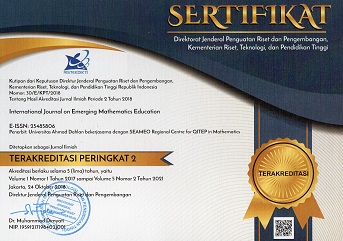Using Context of Local Environment Maps to Develop Lesson Plan which Foster Mathematical Literacy
Abstract
Mathematical litreracy is defined as individual capacity to reason mathematically, to formulate, to employ, and to interpret mathematics, and to solve problems in the various real-life contexts. These skills are important for students but PISA – an OECD program to assess these skills – reported that the Indonesian students’ performance in mathematical literacy remains low for decades mostly due to instructional factor. It also happened in SMP N 2 Cimerak – a junior high school in Pangandaran, Indonesia, that the students still need a lot of improvement in mathematical literacy skills and their teachers also needs to develop capacity to teach the skills. This research aims to develop a valid and practical lesson plans which could be used to foster mathematical literacy. The lesson plans also include powerpoint presentation slides, students’ worksheet, teaching materials, and assessment instrument. It was a modified version of R&D introduced by Plomp which consist of stages: initial investigation, design, construction, evaluation, and final product. In the evaluation stage, we involved four experts to validate the lesson plans and 26 junior high school students to test the lesson plans, and revised them accordingly. The results suggest that the lesson plans are valid with the score of 4.46 (lesson plan), 3.96 (PPT slides), 4.38 (worksheet), 4.00 (teaching materials), dan 4.39 (assessment). The validity could be explained from the accommodation of mathematical literacy domains such as contexts (job and society, local environment maps), content (change and relationship, Cartesian coordinate), process (manifested in the problem-based learning), and the skills (communication, mathematization, representation, reasoning, devising strategies, using symbols, and using mathematics tools). The testing also resulted in 84.19 score of students’ positive responses and 3.92 (good) score of practicality. Moreover, the lessons also have potential effects in fostering students’ mathematical literacy viewed from the observation of mathematical literacy process, which suggest that 3.8% students in low performance, 53.8% students in intermediate performance, and 42.3% students in high performance. Therefore, the lesson plans were valid, practical, and having potential effect in fostering students’ mathematical literacy.
Full Text:
PDFDOI: http://dx.doi.org/10.12928/ijeme.v7i1.25764
Refbacks
- There are currently no refbacks.
Copyright (c) 2023 Vita Istihapsari

This work is licensed under a Creative Commons Attribution-ShareAlike 4.0 International License.
International Journal on Emerging Mathematics Education
Kampus 2 Universitas Ahmad Dahlan
Jalan Pramuka No. 42, Pandeyan, Umbulharjo, Yogyakarta - 55161
Telp. (0274) 563515, ext. 4902; Fax. (0274) 564604
Email: ijeme@uad.ac.id
p-ISSN: 2549-4996 | e-ISSN: 2548-5806
This work is licensed under a Creative Commons Attribution 4.0 International License

